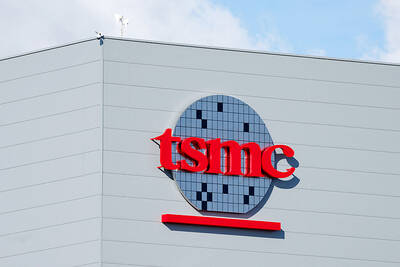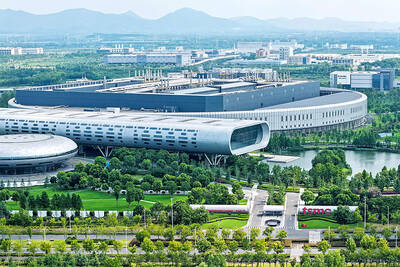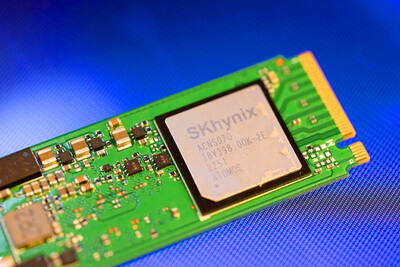Taiwan’s economy is set to receive a substantial boost this year from Taiwan Semiconductor Manufacturing Co’s (TSMC, 台積電) unprecedented spending spree, as the chipmaking giant accelerates plans to build more factories.
Taiwan’s largest company revealed plans earlier this month to spend between US$40 billion and US$44 billion this year on new plants to help ease the shortage of semiconductors. That is equivalent to about 5 percent of Taiwan’s US$760 billion economy, based on the government’s GDP estimates for 2021.
While a portion of TSMC’s capital expenditure goes overseas, the majority is spent at home to expand factories to make its highly sought-after semiconductors.
Winston Chiao, an economist at Taipei-based Taishin Securities, said that TSMC’s spending plans prompt him to upgrade his most recent forecast of 4.2 percent GDP growth this year.
“TSMC’s US$30 billion outlay on capex last year triggered a series of investment spending and new factory construction in all the companies in its supply chain, such as steel, chemicals and other raw materials,” he said on Wednesday.
Taiwan’s GDP grew 6.28 percent last year, the Directorate-General of Budget, Accounting and Statistics (DGBAS) said. That was the fastest rate of expansion since the rebound in 2010 after the global financial crisis.
Growth was predominantly fueled by a stellar year for Taiwan’s exporters. Global demand for semiconductors and other electronic products surged, driven by rebounding consumer spending as most countries eased their COVID-19 lockdowns through the year.
Corporate revenues reflected this, with the combined annual sales of companies on the Taiwan Stock Exchange rising 15 percent to a record NT$38.2 trillion (US$1.37 trillion), according to a statement from the bourse.
The benchmark TAIEX reached multiple record highs throughout the year, and the Taiwan dollar hit a new 24-year high.
The main risk for the economy this year is whether the government adopts strict new measures to stamp out a new COVID-19 outbreak.
Domestic consumption is forecast to have rebounded in the fourth quarter of last year after a partial lockdown in the spring and summer shut down entertainment venues and banned in-restaurant dining.
Renewed restrictions could risk further exacerbating growing imbalances between sectors that rely on domestic consumption and thriving export industries, Natixis SA’s Asia-Pacific chief economist Alicia Garcia Herrero said.
“This divergence in growth has begun to affect wages and inflation,” she wrote in a report released on Wednesday. “Sectors related to global trade, such as semiconductors and shipping, have enjoyed high wage growth, while the services sector is in a parallel universe.”
She said that Taiwan’s economy could face non-export sectors being unable to keep pace with the tech industry, leading to rising inequality.
The government is projecting domestic consumption to rise 5.36 percent this year.
“With fewer and fewer countries aiming for COVID-zero and Taiwan also expected to learn to live with the virus, we will not likely go back to the lockdown stage which dragged the domestic sectors back in 2021,” Chiao said.

Taiwan Semiconductor Manufacturing Co (TSMC, 台積電) secured a record 70.2 percent share of the global foundry business in the second quarter, up from 67.6 percent the previous quarter, and continued widening its lead over second-placed Samsung Electronics Co, TrendForce Corp (集邦科技) said on Monday. TSMC posted US$30.24 billion in sales in the April-to-June period, up 18.5 percent from the previous quarter, driven by major smartphone customers entering their ramp-up cycle and robust demand for artificial intelligence chips, laptops and PCs, which boosted wafer shipments and average selling prices, TrendForce said in a report. Samsung’s sales also grew in the second quarter, up

LIMITED IMPACT: Investor confidence was likely sustained by its relatively small exposure to the Chinese market, as only less advanced chips are made in Nanjing Taiwan Semiconductor Manufacturing Co (TSMC, 台積電) saw its stock price close steady yesterday in a sign that the loss of the validated end user (VEU) status for its Nanjing, China, fab should have a mild impact on the world’s biggest contract chipmaker financially and technologically. Media reports about the waiver loss sent TSMC down 1.29 percent during the early trading session yesterday, but the stock soon regained strength and ended at NT$1,160, unchanged from Tuesday. Investors’ confidence in TSMC was likely built on its relatively small exposure to the Chinese market, as Chinese customers contributed about 9 percent to TSMC’s revenue last

LOOPHOLES: The move is to end a break that was aiding foreign producers without any similar benefit for US manufacturers, the US Department of Commerce said US President Donald Trump’s administration would make it harder for Samsung Electronics Co and SK Hynix Inc to ship critical equipment to their chipmaking operations in China, dealing a potential blow to the companies’ production in the world’s largest semiconductor market. The US Department of Commerce in a notice published on Friday said that it was revoking waivers for Samsung and SK Hynix to use US technologies in their Chinese operations. The companies had been operating in China under regulations that allow them to import chipmaking equipment without applying for a new license each time. The move would revise what is known

UNCERTAINTY: A final ruling against the president’s tariffs would upend his trade deals and force the government to content with billions of dollars in refunds The legal fight over US President Donald Trump’s global tariffs is deepening after a federal appeals court ruled the levies were issued illegally under an emergency law, extending the chaos in global trade. A 7-4 decision by a panel of judges on Friday was a major setback for Trump, even as it gives both sides something to boast about. The majority upheld a May ruling by the Court of International Trade that the tariffs were illegal. However, the judges left the levies intact while the case proceeds, as Trump had requested, and suggested that any injunction could potentially be narrowed to apply